| Introduction | Forest Types | |
| Forest Characteristics | Management | |
| Forest Contributions | Special Considerations | |
| The Forest Plan | Assistance |
![]()
FOREST MANAGEMENT GUIDELINES FOR MICHIGAN |
| Introduction | Forest Types | |
| Forest Characteristics | Management | |
| Forest Contributions | Special Considerations | |
| The Forest Plan | Assistance |
![]()
FOREST MANAGEMENT GUIDELINES FOR MICHIGAN |
Upland Forest Types The extensive uplands of Michigan are of glacial origin. They include hilly ice-contact features—moraines, kames, eskers, drumlins, and crevasse fillings—as well as flat or gently undulating till plains, outwash plains, and well-drained former lakebeds. Near the shore of Lake Michigan and in some inland areas, wind-shaped sand dunes also occur. In the highlands of the western Upper Peninsula, ancient bedrock forms prominent, mountainous ridges. Upland habitats are extremely diverse, with local differences in climate and history adding their influence to habitat variation.
|
||
| Southern Maple Beech Forests Occupying southern mesic habitats, this type is the most species rich and productive in the state. Soils are deep, loamy, generally well-drained, and fertile. Because it is so productive, much of the pre-European settlement mesic forest of southern Michigan was cleared for farming. Within 10 to 20 miles of the Great Lakes, the humid climate also permits mesic forests to thrive on stabilized sand dunes. The signature trees are sugar maple and American beech. Sugar maple usually dominates in the richest mesic habitats, whereas beech is better adapted to sandy soils or those with somewhat poorer internal drainage. Seedlings and saplings of both species usually are abundant in the understory, except where deer browsing is heavy. A large number of trees can be associated with the maple and beech in the overstory: red oak, white oak, bur oak, chinquapin oak, white ash, tulip poplar, basswood, black cherry, red maple, bitternut hickory, black walnut, and sassafras. White pine and hemlock may be present near the Great Lakes. Maple-beech forests are the most common type in southern Michigan, covering about 1.3 million acres, mostly in scattered woodlots. They are an exceedingly important source of timber, but provide many other benefits as well. |
||
| Southern Oak-Mixed Hardwood Forests This hardwood forest type (also known as oak-hickory) is emblematic of much of southern Michigan. Habitats are dry-mesic or xeric, and soils are typically moderately fertile to infertile, coarse-textured, acid sandy loams and sands. Prior to European settlement, much of the land now in this forest type probably was oak openings - open savanna communities maintained by frequent fires. Some of this land also was converted to agriculture by Euro-American settlers. This is an oak-dominated forest type, with black oak, white oak, and red oak the signature species. A number of associated trees may be present, sometimes outnumbering the oaks, especially if a stand has been selectively logged in the past: shagbark hickory, pignut hickory, sassafras, black cherry, red maple, bur oak, scarlet oak, northern pin oak, white ash, basswood, black walnut, bigtooth aspen, red cedar, and white pine (near Lake Michigan). Dry-mesic oak forests are common in southern Michigan, covering about 700,000 acres. They are an important source of timber and provide prime habitat for wildlife. |
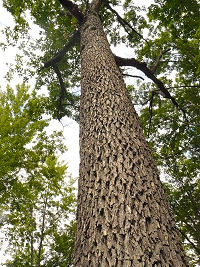 |
|
| Northern Maple-Mixed Hardwood Forests This type (sometimes called maple-beech-birch) is the northern counterpart of the southern maple-beech forest. But because growing seasons are shorter, winter temperatures colder, and snowfall greater, southern hardwood species drop out, with their place taken by northern species. These forests are rich and productive; soils are mostly well-drained, acid loamy sands to loams. Although agriculture is not as pervasive in northern Michigan as it is in the south, some of this type was converted to farm land. One hallmark tree—sugar maple—usually dominates, sometimes forming nearly pure stands. American beech also is important, although its range does not include the western Upper Peninsula. In some areas (e.g., the eastern Upper Peninsula), this species has been devastated by the beech bark disease. Yellow birch, red oak, and basswood may be important associates on certain sites, but sugar maple usually is present in the overstory or understory. Minor canopy associates include red maple, white ash, black cherry, paper birch, bigtooth aspen, quaking aspen, eastern hemlock, white pine, white spruce, and northern white cedar (especially sand dunes and calcareous soils). Hemlock and white pine were much more common in this type in pre-European settlement times than today, but heavy cutting of these species during the late 19th and early 20th centuries, combined with repeated wildfires, reduced their frequency. At about 5.9 million acres, this is the most widely distributed forest type in Michigan, and it produces much high-quality timber. |
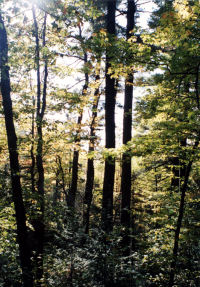 |
|
| Northern Hemlock Forests Although hemlock can be a minor component of northern maple-mixed hardwood forests, some communities are dominated by hemlock. They typically occur on cool, moist coastal dunes of Lakes Michigan and Superior and on the north-facing slopes of ridges and ravines. Because the soils in these habitats are mostly dry-mesic acid sands or sandy loams, sugar maple is rare. Associates of hemlock can be American beech (except in the western Upper Peninsula), red maple, paper birch, yellow birch, red oak, white pine, white spruce, and balsam fir (the latter two usually in the understory). Not widely distributed, this type (about 228,000 acres) nonetheless can be found in its unique habitat across northern Michigan, especially in the western Upper Peninsula. Although the bark of hemlock was once harvested in huge quantities for use in the leather tanning industry, this type has very little commercial value today, save some salvage of disease-killed beech. |
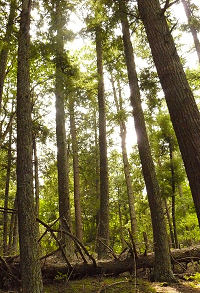 |
|
| Northern Oak Forests This extensive type is found on acid, moderately fertile or infertile, well-drained sands or loamy sands. It is largely an accident of human history. Prior to 19th and early 20th century logging, many northern areas now dominated by oaks were white and red pine forests, with oaks a minor component. The repeated wildfires that accompanied logging and settlement prevented the pines from re-establishing but favored the strong-sprouting, fire-adapted oaks. If undisturbed, many of these forests are now reverting back to pine. White oak, black oak, and northern pin oak in varying combination are the signature trees, with white pine, red oak, red pine, jack pine, black cherry, red maple, bigtooth aspen, quaking aspen, hemlock, and balsam fir occurring as associated species. The northern oak type occurs to a small extent in the Upper Peninsula, but most of it (about 1.2 million acres) occurs in the northern Lower Peninsula. This type provides critical acorn mast for wildlife and is harvested for timber, although many of the oaks are poor quality. |
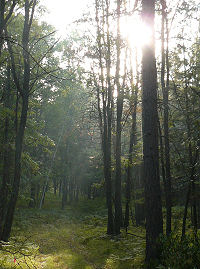 |
|
| Northern Pine Forests Northern xeric and dry-mesic habitats once supported the magnificent old-growth pine forests that made Michigan famous. This present-day type represents a second-growth reincarnation of these forests in areas where post-logging wildfires were not severe or repeated. The type gets its name from the three native Michigan pines: red (Norway) pine, white pine, and jack pine. Red pine and jack pine predominate on dry, sandy soils, whereas white pine will predominate on more mesic, sandy loam habitats. It is not unusual to see all three pines growing together, although red pine-jack pine or red pine-white pine mixtures are more common. Numerous hardwood and conifer trees can be associated with the pines: white oak, black oak, northern pin oak, red oak, red maple, black cherry, bigtooth aspen, quaking aspen, paper birch, hemlock, balsam fir, and white spruce. Historically, pine forests occurred in their greatest extent in the northern Lower Peninsula; at nearly 1.21 million acres, this remains true today. Extensive areas of this type are also found in the Upper Peninsula (about 644,000 acres). Pine forests are very important commercially, and young stands of jack pine are the only breeding habitat for the endangered Kirtland’s warbler. Wildfires have always been common in these highly flammable forests, and they remain a serious threat today. |
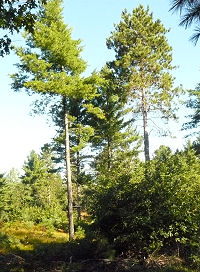 |
|
| Boreal Spruce-Fir Forests True northern boreal forests occupy huge areas in Canada and Alaska, but they are also represented in a southern variant in northern Michigan. They typically occupy cool, mesic to wet-mesic habitats; soils vary from well-drained to somewhat poorly drained, acid to neutral, light sands to heavy clay loams. Two conifers usually dominate the overstory—white spruce and balsam fir. Northern white cedar is also common on sand dunes and in areas of calcareous bedrock. Minor tree associates include paper birch, yellow birch, quaking aspen, red maple, white pine, and hemlock. This type is very localized in the northern part of the Lower Peninsula but is more extensive in the Upper Peninsula, comprising about 540,000 acres in total. Some limited extraction of spruce-fir pulpwood and white cedar logs occurs, but overall the type is not commercially important. |
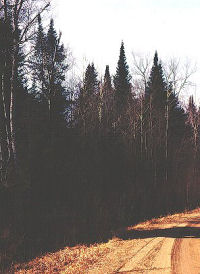 |
|
| Aspen-Paper Birch Forests With the exception of a few small areas of virgin forest—now mostly protected in parks—Michigan’s tree communities are second or third growth. The forests that grew back after 19th and early 20th century logging and wildfires or when marginal agriculture was abandoned consisted of vast areas of early successional hardwood pioneers that were exceptionally well-adapted to establish on highly disturbed sites. These pioneer forests occupy a wide variety of soils and habitats, from xeric to very wet-mesic. Quaking aspen, bigtooth aspen, and balsam poplar are benchmark species of this type. Their ability to produce large quantities of cottony, wind-blown seed and sprout copiously from shallow roots make them well-adapted for the pioneer role. Paper birch is also an important pioneer, especially in the Upper Peninsula. In the southern Lower Peninsula cottonwood is an aggressive invader of disturbed sites. These pioneer communities contain numerous hardwood and coniferous tree associates, often growing in the understory or subcanopy, and they eventually will succeed the overstory pioneers. About 3.2 million acres of early successional aspen-birch forests remain in the state today, a decline of over one-third from their peak acreage in the 1930s. About 96% of the current area lies in the northern Lower Peninsula and Upper Peninsula. These forests are an extremely important source of timber, and they provide excellent wildlife habitat. |
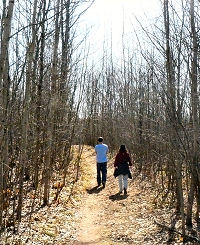 |
|
| Plantations Trees have long been planted in Michigan for forestry purposes, usually on burned-over or cut-over tracts and abandoned fields or pastures. Most successful tree planting in the state has occurred on dry-mesic or mesic habitats. Some plantings have also occurred on very dry or very wet sites, but failure rates often have been high. Significant wild land planting began in the 1920s, reached peaks during the Civilian Conservation Corps era in the late 1930s and early 1940s, during the Soil Bank era in the 1950s, and, more recently, on Conservation Reserve Program lands. In recent years, between 25,000 and 30,000 acres per year have been planted in Michigan, much of it on public land. The bulk of the planting on private land is for Christmas trees. Most of Michigan’s existing wildland plantations consist of either red pine or jack pine, with the area planted with red pine nearly double that of jack pine. Other trees occasionally found in forest plantations include white pine, Austrian pine, Scotch pine, white spruce, Norway spruce, and European larch. Only three hardwoods—black walnut, red oak, and hybrid poplar—have been planted to any extent, but their acreage is small compared to conifers. Plantations occur in every region of the state, with the largest area in the northern Lower Peninsula. Older plantations are being actively harvested for wood products, but planting continues, so this type will be an enduring feature of Michigan’s forested landscape. |
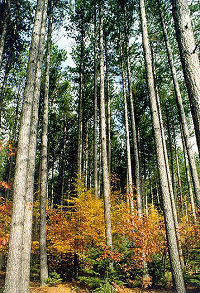 |
|

This website is maintained by Bill Cook, Michigan State University Extension
Forest in the Upper Peninsula. Comments, questions,
and suggestions are gratefully accepted.
Last update of this page was 9 January, 2014
This site is hosted by School of Forest Resources and Environmental Science at Michigan Technological University.